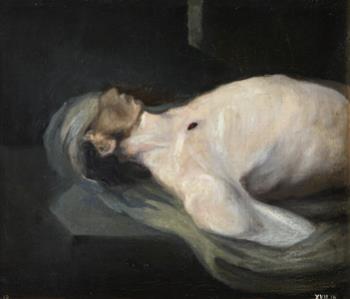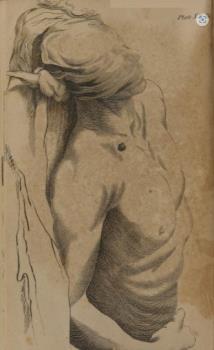- Gunshot wound to the collarbone and scapula
- GC.13829
- Charles (1774-1842) Bell (Artist)
- Gunshot wound to the collarbone and scapula. Sketch in oil, glazed, in wooden frame. Of an officer wounded by a musket ball at the battle of Corunna (1809) and was thereafter conveyed to Portsmouth. One of Charles Bell's paintings of a casualty from the Battle of Corunna and the retreat between 24 December 1808-11 January 1809. Bell treated some of the force that landed back in Britain at Portsmouth. There are fifteen images in all. Bell's notes: "The musket ball is lodged in the back of the scapula this I took from the body of Capt ... The ball entered in the breast, broke the end of the clavicle, entered the chest, and went across the lungs, broke a rib on the back part, stuck in the scapula the spent ball being nearly divided in two by the spine of the scapula; I was present when he was brought ashore in Portsmouth, in a very exhausted condition, and labouring in his breathing, he died the next day, which was the twelfth from receiving the wound. On opening the body I was astonished at finding the quantity of serum, which poured out from the chest, as out of a barrel, the lungs were condensed and gorged with blood, he would have been much relieved by the operation of paracentesis." Paracentesis would have drained fluid from the thorax, and, if done promptly, may have saved the patient's life. If, however, the straw-coloured fluid that Bell saw came from damage to the right thoracic duct rather than being old blood, this would not have ceased to drain, and the patient would have died anyway through fluid loss and protein depletion. In Operative Surgery he tells us: "This gentleman survived the first danger of suffocation from blood escaping into the cells of the lungs, and into the trachea. He also bore the first rising of the inflammation : but died on the twelfth day, from the extent of serous effusion in the thorax. When I made the incision into the chest, the fluid spouted out, and continued to flow as from a cask. All the upper part of the lungs of the left side, were of a liver-like firmness, from extravasation and inflammation." The bone had not only caused bony damage, but had passed through the upper right lung, causing bleeding and partial lung collapse, leading to the laboured breathing that Bell observed when he was brought ashore in Portsmouth
- Nineteenth century, early
Height: Framed 45.5 cm
Height: Canvas 30.5 cm












